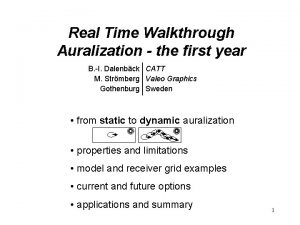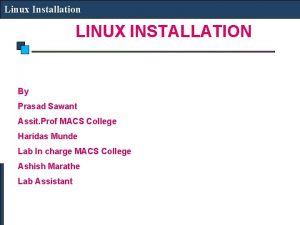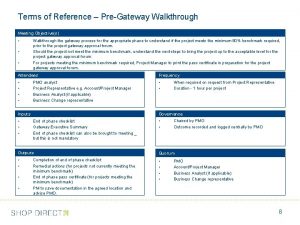Tools walkthrough Saikat Asaduzzaman Exiftool Installation in Linux













- Slides: 13

Tools walkthrough Saikat Asaduzzaman

Exiftool - Installation in Linux • Type this to install in Kali Linux: sudo apt install exif • If you get an error of dpkg, then type this to resolve it: sudo dpkg -configure -a • Then type this again: sudo apt install exif • Install Perl library dependency with this: sudo apt install libimageexiftool-perl

Exiftool - Usage • Get metadata with this command: exif “filename” • List all tags with this command: exif -l “filename” • Extract thumb nail with this: exif -e “filename” • Create exif data if its not there: exif -c “filename” Ref: https: //exiftool. org/

FOCA Installation in Windows • Install FOCA from the Eleven Path website: https: //www. elevenpaths. com/innovation-labs/tools/foca • Click download button and it till take you to the Git. Hub page • Scroll down to the middle of the page under Releases section and click “here” • You also need to download SQL Server Express edition to run FOCA, get it from here: https: //www. microsoft. com/en-us/sql-server/sqlserver-downloads

FOCA Usage • Launch the tool, create project • Adjust the plugins from the Options tab • Also check the module filter to FOCA only

FOCA usage • Download all files from the target site • Then analyze the metadata • Go under metadata summary and check out the metadata

NMAP scripting engine (NSE) in Linux • NMAP has a bunch of scripts that you can run using its scripting engines • The script can range from simple search as finding a banner to complex brute forcing with custom word list. • Try this command in terminal: • $nmap --script banner <website name>

NMAP scripting engine (NSE) in Linux • Using http-grep: To grep a key word from the target server • e. g: nmap -p 80 www. okta. com --script http-grep --script-args 'httpgrep. builtins ={"mastercard", "discover"}, http-grep. url="okta. html"'

NMAP scripting engine (NSE) in Linux • Using http-enum: Enumerates directories used by popular web applications and servers. • e. g: nmap --script http-enum scanme. nmap. org

NMAP scripting engine (NSE) in Linux • Using dns-brute: Attempts to enumerate DNS hostnames by brute force guessing of common subdomains • e. g: nmap --script dns-brute scanme. nmap. org

Dig - in Linux • Modern Kali might not have Dig installed by default, install it with sudo apt install dnsutils • verify by dig -v • Use DNS Cache Snooping with this: dig @8. 8 microsoft. com A +norecurse

DNS Recon - in Linux • dnsrecon -d scanme. nmap. org -D /usr/share/dnsrecon/namelist. txt • dnsrecon -d <website name>

DNS Recon - in Linux • Dnsrecon reverse lookup - trying to find out IP addresses from domain names • Use this: dnsrecon -d <target website> -w
 What was saikat doing at 6 o'clock yesterday
What was saikat doing at 6 o'clock yesterday Saikat pronunciation
Saikat pronunciation Saikat islam lives with his parents in a flat in bogra
Saikat islam lives with his parents in a flat in bogra Linux linux security module m1 support
Linux linux security module m1 support Uclinux
Uclinux Linux gui development tools
Linux gui development tools Kali linux suomi
Kali linux suomi Gaa case 3 walkthrough
Gaa case 3 walkthrough Cognitive walkthrough vs heuristic evaluation
Cognitive walkthrough vs heuristic evaluation The freshman year walkthrough
The freshman year walkthrough Requirements walkthrough
Requirements walkthrough Cognitive walkthrough vs heuristic evaluation
Cognitive walkthrough vs heuristic evaluation Classroom walkthrough app
Classroom walkthrough app Adventure high walkthrough
Adventure high walkthrough

























